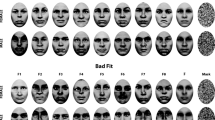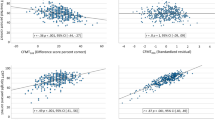Abstract
Hommel and Lippa (1995) found a left—right spatial compatibility effect with respect to a background context of Marilyn Monroe’s face, rotated 90° clockwise or counterclockwise from upright, when subjects responded to up or down stimuli by pressing a left or a right key. They interpreted their results as providing evidence for object-based coding of stimulus location. We conducted four experiments in order to evaluate the reliability of this face context effect, to control for possible artifacts and evaluate alternative explanations, and to establish generalizability to other face contexts. This was accomplished by using not only the original photograph, but also a mirror-reversed image, chimeric faces composed from the left or the right sides of the original photograph, an outline drawing face, and a circle with markings for facial features. Our results were much stronger than those of Hommel and Lippa, and the face context effect was found for all of the face variations. Our experiments also provided evidence to suggest that asymmetric coding of the up and down locations contributes to performance in the face context as well.
Similar content being viewed by others
References
Adam, J. J., Boon, B., Paas, F. G. W. C., &Umiltà, C. (1998). The up-right/down-left advantage for vertically oriented stimuli and horizontally oriented responses: A dual-strategy hypothesis.Journal of Experimental Psychology: Human Perception & Performance,24, 1582–1595.
Bauer, D. W., &Miller, J. (1982). Stimulus—response compatibility and the motor system.Quarterly Journal of Experimental Psychology,34A, 367–380.
Bradley, D. R., &Russell, R. L. (1998). Some cautions regarding statistical power in split-plot designs.Behavior Research Methods, Instruments, & Computers,30, 462–477.
Dutta, A., &Proctor, R. W. (1992). Persistence of stimulus-response compatibility effects with extended practice.Journal of Experimental Psychology: Learning, Memory, & Cognition,18, 801–809.
Farah, M. J., Wilson, K. D., Drain, M., &Tanaka, J. N. (1998). What is “special” about face perception?Psychological Review,105, 482–498.
Hommel, B. (1994). Effects of irrelevant spatial S-R compatibility depend on stimulus complexity.Psychological Research,56, 179–184.
Hommel, B., &Lippa, Y. (1995). S-R compatibility effects due to context-dependent spatial stimulus coding.Psychonomic Bulletin & Review,2, 370–374.
Hommel, B., &Prinz, W. (Eds.) (1997).Theoretical issues in stimulus-response compatibility. Amsterdam: North-Holland.
Ladavas, E., &Moscovitch, M. (1984). Must egocentric and environmental frames of reference be aligned to produce spatial S-R compatibility effects?Journal of Experimental Psychology: Human Perception & Performance,10, 205–215.
Lamberts, K., Tavernier, G., &d’Ydewalle, G. (1992). Effects of multiple reference points in spatial stimulus-response compatibility.Acta Psychologica,79, 115–130.
Lippa, Y. (1996). A referential-coding explanation for compatibility effects of physically orthogonal stimulus and response dimensions.Quarterly Journal of Experimental Psychology,49A, 950–971.
Lu, C.-H., &Proctor, R. W. (1995). The influence of irrelevant location information on performance: A review of the Simon and spatial Stroop effects.Psychonomic Bulletin & Review,2, 174–207.
Michaels, C. F. (1989). S-R compatibilities depend on eccentricity of responding hand.Quarterly Journal of Experimental Psychology,41A, 263–272.
Michaels, C. F., &Schilder, S. (1991). Stimulus—response compatibilities between vertically oriented stimuli and horizontally oriented responses: The effects of hand position and posture.Perception & Psychophysics,49, 342–348.
Nicoletti, R., &Umiltà, C. (1994). Right—left prevalence in spatial compatibility.Perception & Psychophysics,35, 333–343.
Proctor, R. W., &Dutta, A. (1993). Do the same stimulus—response relations influence choice reactions initially and after practice?Journal of Experimental Psychology: Learning, Memory, & Cognition,19, 922–930.
Proctor, R. W., &Reeve, T. G. (Eds.) (1990).Stimulus—response compatibility: An integrated perspective. Amsterdam: North-Holland.
Reeve, T. G., &Proctor, R. W. (1990). The salient-features coding principle for spatial- and symbolic-compatibility effects. In R. W. Proctor & T. G. Reeve (Eds.),Stimulus—response compatibility: An integrated perspective (pp. 163–180). Amsterdam: North-Holland.
Roswarski, T. E., &Proctor, R. W. (1996). Multiple spatial codes and temporal overlap in choice-reaction tasks.Psychological Research,59, 196–211.
Umiltà, C. (1991). Problems of the salient-features coding hypothesis: Comment on Weeks and Proctor.Journal of Experimental Psychology: General,120, 83–86.
Weeks, D. J., &Proctor, R. W. (1990). Salient-features coding in the translation between orthogonal stimulus and response dimensions.Journal of Experimental Psychology: General,119, 355–366.
Weeks, D. J., Proctor, R. W., &Beyak, B. (1995). Stimulus—response compatibility for vertically oriented stimuli and horizontally oriented responses: Evidence for spatial coding.Quarterly Journal of Experimental Psychology,48A, 367–383.
Author information
Authors and Affiliations
Corresponding author
Rights and permissions
About this article
Cite this article
Proctor, R.W., Pick, D.F. Deconstructing Marilyn: Robust effects of face contexts on stimulus—response compatibility. Mem Cogn 27, 986–995 (1999). https://doi.org/10.3758/BF03201229
Received:
Accepted:
Published:
Issue Date:
DOI: https://doi.org/10.3758/BF03201229




